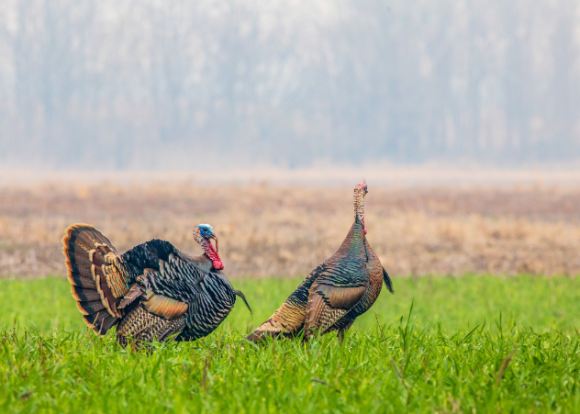
(Photo Credit: Darcy Daniels)

(Photo Credit: Darcy Daniels)
|
New Research to Address Declines Linked to Roost Sites
The NWTF is funding a new wild turkey research project in the Texas Rolling Plains Ecoregion, located in the north-central part of the state.
The project will help the Texas Parks and Wildlife Department better understand changes in available roosting habitat over the last 20 years and how roost sites are negatively impacted by encroaching invasive vegetative species, like Russian olive and salt cedar. The research will utilize state-of-the-art imaging techniques to classify over 20 years of landscape-scale data. It will also provide insight into future management needs, helping slow the spread of invasive species and bolstering Rio populations in the region.
“TPWD, NWTF and Texas A&M University are collaborating to take a closer look at larger landscape habitat changes,” said Jason Hardin, TPWD wild turkey program leader and co-chair of the NWTF Technical Committee. “The focus of this work is on the potential loss of wild turkey roosting cover, primarily cottonwood trees in the Rolling Plains, which may have been exacerbated by the 2011 drought. These partners will examine changes in brush cover along the riparian corridors where wild turkeys are primarily found in the Rolling Plains. TPWD and NWTF have a keen interest in finding answers so that we can provide management options to landowners in this historic stronghold for wild turkeys.”
The Rolling Plains region is characterized by its gently rolling open-country landscape, interspersed with rivers and streams. The waterways (riparian areas) provide essential habitat for the Rio Grande wild turkeys that inhabit the area. These riparian areas, however, are where much of roosting habitat is diminishing.
With no shortage of predators in the region, Rio Grande wild turkeys are particular about their roost sites. Rios like to roost in large trees, both in diameter and height. Previous research found the birds’ average preferred roost tree size was about 45 feet tall and about 23 inches in diameter.
What’s more, even if trees fit the size preference for Rios, if invasive brush has taken hold, Rios will often avoid roosting in those trees, likely to avoid predators lurking in the brush. The brush is also poor for the overall health of trees like the cottonwood. The woody vegetation encompasses the tree, competing for water and nutrients and making the trees more susceptible to damage from fire and other disturbances.
The scarcity of quality roosting trees due to development, habitat fragmentation and over-browsing, coupled with the increasing encroachment of invasive brush around quality roost trees that do exist is a real problem for the birds in the region. This research seeks to directly correlate Rio distribution and population densities based on quality roosting sites and how to best manage the areas that have been negatively affected.
“In this region, wild turkey distribution is strongly dependent on roosting habitat, which consists of preferred tree species, like cottonwood and an open understory beneath roost trees,” said Stephen Webb, Ph.D., senior research scientist at Texas A&M Natural Resources Institute. “Invasive species such as Russian olive and salt cedar are widespread and are expanding, negatively affecting preferred roost trees and reducing their growth and regeneration.”
Webb is the primary investigator in this research project. He and his team will classify, analyze and map two decades' worth of habitat changes from satellite and aerial imagery from the National Agriculture Imagery Program. LiDAR technology will refine the imagery further, providing a 3D representation of the vegetative structure of the landscape.
Once the plant species are classified and mapped, Webb and his team will identify factors that have caused change. For instance, if an area that has not received any management in two decades is covered in invasive species around roost trees, they will be able to pinpoint the lack of management as the culprit. Webb’s team of researchers also will look for more nuanced issues causing reduced quality roosting habitat, like overgrazing and development. The results will allow for the prioritization of management intervention across the landscape.
“This research will document and map the impact that woody plant encroachment and invasive species have had on potential roost sites over two decades,” Webb said. “Results obtained during our study will provide scientific evidence for managing wild turkeys and their habitat requirements to promote sound land stewardship.”
This project is one of seven new research projects the NWTF is funding. At the 12th National Wild Turkey Symposium in 2022, the NWTF announced its new $360,000 investment into wild turkey research.
In addition to the recent investment, the organization further illustrated the importance of research by committing to hold the 13th National Wild Turkey Symposium in 2025.The symposium is usually held every five years, but the NWTF is working to fast-track the meeting of researchers and managers to turn the tide of population declines.
National Wild Turkey Federation
PO Box 530
Edgefield South Carolina 29824
United States